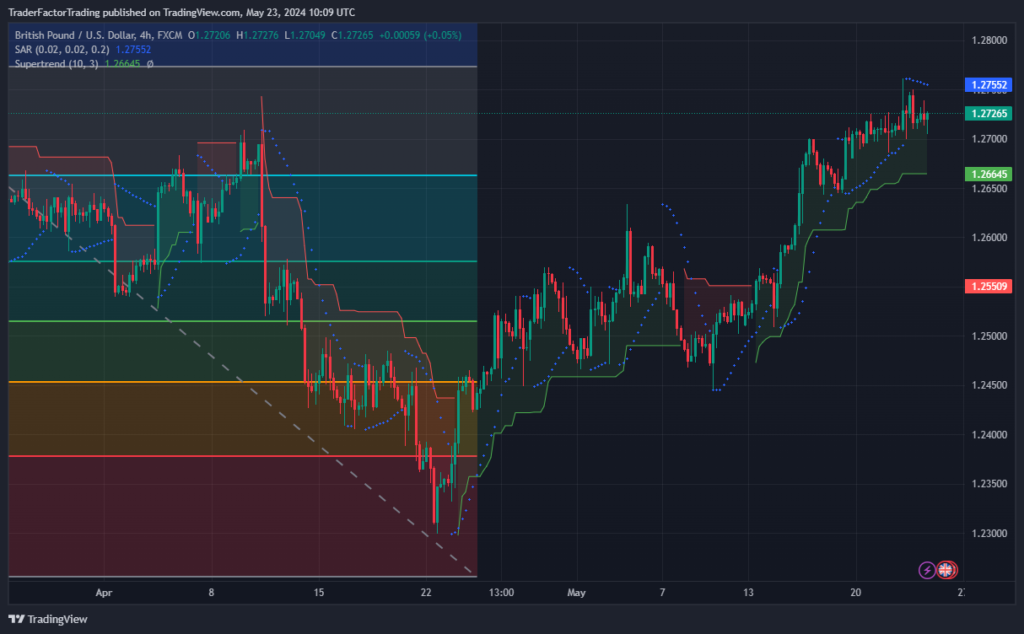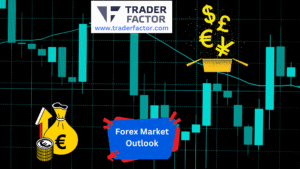As market participants brace for a wave of economic data this Thursday, the potential for significant market movements is high. The release of Flash Manufacturing and Services PMIs across the Eurozone, the UK, and the US will provide crucial insights into economic health and business activity.
Forex traders should remain vigilant, as these reports have the potential to impact the EUR, GBP, and USD significantly. With the Fed’s hawkish stance, the ECB’s potential rate cuts, and fluctuating PMI data, the landscape is ripe for volatility. Stay tuned for rapid developments as these key economic indicators roll out.
Table of Contents
ToggleEUR/USD Holds Above 1.0800 After German and EU PMI Data
EUR/USD holds above 1.0800 in the European session on Thursday as data from Germany and the EU reveal that business activity in the private sector expanded at an accelerating pace in May, helping the Euro find demand. The robust PMI figures have given the Euro a boost, settling above the critical 1.0800 mark. However, US PMI reports are still pending and could sway the market further.
EURUSD Chart
The US Dollar (USD) managed to extend its weekly recovery and keep the risk complex under heightened pressure on Wednesday, pulling EUR/USD to fresh five-day lows near the 1.0820 region. The decent bounce in the Dollar coincided with a generally positive performance in US yields across different durations, as investors continued to anticipate the Federal Reserve (Fed) beginning its easing cycle in September, in contrast to the possibility of the European Central Bank (ECB) initiating interest rate cuts potentially as early as June.
GBP/USD Clings to Small Gains Above 1.2700
GBP/USD is clinging to recovery gains above 1.2700 in European trading on Thursday. The PMI data from the UK showed that Composite PMI edged lower to 52.8 in May (preliminary) from 54.1 in April, limiting Pound Sterling’s gains ahead of key data releases from the US.
GBPUSD 4-hour Chart

While the numbers show a slight decline in business activity, the GBP/USD pair remains resilient. Traders are likely to focus on upcoming US data to gauge the pair’s next moves. Any significant changes in US economic indicators could either bolster or diminish the GBP’s current standing.
Gold Price Extends the Downside on Fed’s Hawkish Stance
Gold price trades with a negative bias on Thursday. The hawkish stance of the FOMC minutes from last month’s meeting might cap the precious metal’s upside. Investors are turning their attention to the first reading of US PMI data for May, due on Thursday, which could provide additional cues on the direction of Gold prices.
The Federal Reserve’s ongoing hawkish stance has put downward pressure on Gold, with the precious metal struggling to gain traction amid expectations of tighter monetary policy. Traders will be closely monitoring the PMI data to assess how it will influence the Fed’s future actions and, consequently, Gold prices.
Defining Flash Manufacturing PMI
Flash Manufacturing PMI offers an essential glimpse into a country’s manufacturing sector health by estimating activity based on the majority of monthly survey responses. As you’re examining indicators, this one’s vital for gauging economic trends and preparing for market reactions. It’s critical for understanding how manufacturing activity is performing, which in turn influences currency movements.
When you delve into the Flash Manufacturing PMI, you’re getting a snapshot ahead of final PMI data, allowing you to anticipate changes in the economic landscape. This anticipation can be a game-changer, especially if you’re involved in forex trading or international investments. Knowing whether the PMI is above or below the critical 50-point mark can help you predict whether a currency will strengthen or weaken.
Moreover, this indicator is not just about numbers; it reflects real-world manufacturing conditions. Are new orders up? Is production capacity maxed out? These details shape the narrative of economic health and directly impact how markets move. By keeping an eye on these early reports, you’re better equipped to make informed decisions, tweak your strategies, and stay ahead in a rapidly changing economic environment.
Importance of PMI Readings
Understanding the importance of PMI readings helps you grasp how these metrics reflect broader economic trends and influence market dynamics. These indicators are vital for analyzing variables that paint a picture of the economic landscape, not just locally but globally. By tracking shifts in manufacturing through PMI, you’re tapping into a wealth of investment insights and gaining a clearer view of the future outlook.
Here are three key elements to take into account:
- Global Reporting: PMI data isn’t just about one region; it’s a pulse on global economic health. Countries around the world report these figures, providing a tapestry of economic strength or weakness.
- Related Indicators: PMI readings don’t stand alone. They’re part of a network including other economic indicators like GDP growth rates and employment figures. Together, these shape a fuller view of economic stability and currency strength.
- Strengths and Limitations: While PMI offers timely updates, it’s crucial to recognize its scope is primarily manufacturing-focused. Understanding both the strengths and the limitations can guide you better in making informed decisions, especially in volatile markets.
Market Impact of Flash PMI
The release of Flash PMI data greatly influences market trends, particularly in the foreign exchange and stock markets. When this data hits the market, you’ll see immediate fluctuations in currency values and stock prices. It’s a pivotal moment for traders who rely on these figures to gauge the economic health of a manufacturing sector.
Understanding the economic impact of Flash PMI is vital. If the PMI is above 50, it signals expansion, boosting investor confidence and potentially strengthening the country’s currency. Conversely, a reading below 50 can indicate contraction, prompting a cautious approach from investors.
You need to delve into data analysis to fully grasp what these numbers mean. It’s not just about the headline figure; the underlying components like new orders and production levels provide deeper industry insights. These elements paint a broader picture of business conditions, influencing strategic decisions across the financial sector.
Staying updated with Flash PMI data helps you anticipate market movements. Whether you’re a day trader or a long-term investor, these insights can guide your next move, ensuring you’re aligned with the latest economic trends and conditions.
Analyzing PMI Variables
Analyzing PMI variables provides you with a deeper understanding of what’s driving the market’s current conditions. As you explore the data, you’re not just looking at numbers; you’re interpreting the signals of economic health and market directions. This insight is vital for effective market analysis and business forecasting.
Here’s how you should approach this:
- Economic Indicators: These are the core of PMI analysis. You’re examining new orders, production levels, and supplier deliveries. Each indicator tells a story about demand, supply chain efficiency, and production capacity.
- Data Interpretation: This isn’t just about seeing if the figure is above or below 50. You should analyze the trends over months to identify patterns. Is there a consistent rise in new orders? What does that say about consumer confidence and economic activity? This step is important for predicting future market conditions.
- Business Forecasting: Using the insights gained from PMI variables, you can forecast future market trends. Are suppliers delivering more slowly? This might indicate a bottleneck that could affect production rates and lead to changes in stock prices.
Global PMI Reporting Entities
As you consider the insights from PMI variables, it’s helpful to know about the global entities that report these figures. These organizations are pivotal in providing data that greatly influences global economic perspectives, market analysis, and business trends. The most recognized of these entities include the Institute for Supply Management (ISM) in the United States, IHS Markit, which provides PMIs for multiple countries including the U.S., and the Caixin in China, focusing on the vast manufacturing sector there.
These entities gather vast amounts of data from purchasing and supply executives to construct PMIs, which serve as critical economic indicators. Their reports influence financial markets around the world by providing early signals about the health of the manufacturing sector in various economies. The data released by these entities doesn’t just fill news cycles; it guides investment decisions, policy making, and academic research.
Understanding who provides this data and how it impacts the global stage makes you better equipped to interpret its implications. Whether you’re involved in financial analysis, investment, or you’re simply keen on following economic trends, keeping an eye on these reports can provide valuable insights into economic health and business conditions globally.
Strengths of PMI Data
You’ll find that PMI data swiftly reveals the health of the manufacturing sector, offering a reliable gauge for economic activity. As a trader, understanding these figures can be essential for predicting market reactions and preparing for currency movements. PMI data are not just numbers; they represent a pulse check on the manufacturing sector’s contribution to the global economy.
Here are three key strengths of PMI data:
- Timeliness and Relevance: PMI reports are among the first economic indicators released each month. This promptness guarantees you’re getting the latest information, enabling quick decision-making in fast-paced markets.
- Comprehensive Coverage: Beyond merely tracking production levels, PMI surveys encompass new orders, inventory levels, employment, and supplier performance. This breadth provides a 360-degree view of the manufacturing sector, making PMI data a powerful tool in your analysis arsenal.
- Predictive Power: PMI data have proven to be reliable leading economic indicators. Historical trends and current readings can help you anticipate future economic conditions, guiding your investment and trading strategies effectively.
Grasping these aspects of PMI data empowers you to leverage this information in handling the complexities of the global economy and crafting strategies that align with emerging economic trends.
Limitations of Manufacturing PMI
While PMI data offer valuable insights, they also come with limitations that traders need to keep in mind. One major drawback is its narrow focus; the PMI only covers the manufacturing sector, which might not give you the complete picture of a country’s economy. This is particularly true in nations where other sectors like services play a dominant role.
Another challenge is the reliance on survey data, which can be subjective. The responses are based on perceptions and are susceptible to biases, potentially skewing the index. You’ve also got to take into account the regional coverage of the data. PMI might not accurately reflect conditions across the entire country, especially in larger nations where economic conditions can vary significantly from one region to another.
Moreover, while PMI is timely, it’s still only a preliminary snapshot. The final numbers can differ, sometimes substantially, from these initial estimates. This can lead to volatility in trading decisions based on early data releases.
Case Study: Japan’s PMI
In examining Japan’s PMI, we observe a notable decline in manufacturing growth, reflecting broader economic pressures. As you explore the Flash Services PMI analysis and historical PMI trends, you’ll see a pattern that not only impacts the immediate economic landscape but also influences broader market behaviors.
Here’s what you need to visualize:
- Historical PMI Trends: Over the past decades, Japan’s PMI has shown cyclical fluctuations that correlate strongly with major economic events, including global financial crises and domestic policy shifts.
- PMI Survey Methodology: The data you’re seeing comes from a robust survey methodology, gathering responses from purchasing managers across various industries. This method ensures a comprehensive view of the manufacturing sector’s health.
- PMI Impact on Stocks: Each PMI release can trigger volatility in the stock market. A lower than expected PMI often leads to a decline in stock prices, reflecting investor concerns about future economic growth.
Understanding PMI data interpretation is essential. It’s not just about the numbers; it’s about the stories they tell about economic resilience, sector health, and future expectations. Dive deeper into these aspects, and you’ll gain insights that go beyond the surface figures.
Investment Insights From PMI
Understanding how PMI data influences investment decisions can greatly enhance your financial strategy. PMI, or the Purchasing Managers’ Index, acts as a barometer for manufacturing health, providing insights that are vital for developing robust investment strategies. When you’re analyzing PMI data, you’re looking at a detailed snapshot of market trends and economic forecasts that directly impact various sectors.
By integrating PMI insights into your strategy, you can identify trading opportunities before they become evident to the market at large. For instance, a consistent upward trend in PMI might suggest strengthening economic conditions, presenting a prime opportunity to invest in cyclical industries that thrive in such climates. Conversely, a downward trend might signal a slowing economy, prompting you to explore defensive stocks or other safe-haven assets.
Moreover, PMI data aids in detailed industry analysis. It breaks down components like new orders, inventory levels, production, and supplier deliveries, each offering unique insights. This level of detail allows you to tailor your investment approach based on specific industry performances, aligning your portfolio with the most promising sectors according to the latest data. Therefore, PMI not only informs about current conditions but also helps in strategizing investments with a forward-looking approach.
Future Outlook With PMI
Looking ahead, PMI data can be an essential tool for predicting economic trends and making informed investment decisions. As you explore further into the implications of these figures, you’ll discover how they offer crucial global insights and highlight the interplay between market reactions and business conditions.
To truly harness the power of PMI data in forecasting, consider the following aspects:
- Economic Trends: PMI readings serve as a barometer for the economic health of the manufacturing sector. A sustained trend above 50 typically signals expansion, which can be a green light for bullish market strategies.
- Currency Movements: The strength or weakness shown in PMI data often precipitates immediate currency fluctuations. For instance, a robust PMI report can bolster a nation’s currency, offering you a prime opportunity to adjust your forex positions.
- Business Conditions: PMI provides a snapshot of business sentiments, including new orders and employment. These insights can guide you in tailoring your investment portfolio to sectors showing potential growth or contraction.
Related Economic Indicators
Beyond PMI, several other economic indicators play important roles in evaluating a nation’s economic health. You’ll find that understanding these indicators can greatly enhance your trading strategies and market analysis. For instance, the Gross Domestic Product (GDP) provides a broad overview of economic activity and growth trends, while unemployment rates offer insights into labor market health, impacting consumer spending and economic stability.
Interest rates, set by central banks, are essential as they influence financial markets directly. A hike in rates typically strengthens the currency, attracting foreign investment. On the flip side, consumer price index (CPI) and producer price index (PPI) measure inflation levels, which can dictate central bank policies and affect currency value.
Stock market performance is another important indicator. Strong equity markets often reflect investor confidence and economic robustness, influencing global capital flows.
As you explore these economic indicators, you’ll notice patterns and correlations that will deepen your understanding of economic trends. This comprehensive view is crucial not just for predicting market movements but also for crafting robust financial strategies that can withstand unexpected economic shifts. Remember, a well-rounded market analysis isn’t just about observing figures; it’s about interpreting them within the larger economic context.
PMI and Currency Strength
PMI readings greatly impact a country’s currency strength, influencing how traders view its economic stability. You’ve likely noticed fluctuations in currency values around the release of PMI data. Understanding PMI as an economic indicator can help you predict these currency movements more accurately. Let’s delve into by exploring how PMI affects currency strength through market reactions and the interpretation of historical data.
- Economic Indicators and Trader Behavior: PMI is a leading indicator, providing early signs of economic expansion or contraction. If the PMI is above 50, indicating expansion, the currency might strengthen as traders anticipate positive economic growth. Conversely, a reading below 50 can weaken the currency.
- Market Reactions to PMI Releases: The immediate response in the forex markets to PMI numbers can be volatile. Traders analyze not just the current figures but also their deviation from expectations and previous numbers, which can lead to sharp currency movements.
- Historical Data and Trend Analysis: By examining past PMI data, you can identify trends that might influence future market behavior. This analysis helps in setting up trading strategies that align with potential economic cycles, potentially hedging against or capitalizing on currency fluctuations.
Frequently Asked Questions
How Does Geopolitical Tension Influence Flash Manufacturing Pmi?
Geopolitical tension can impact Flash Manufacturing PMI by causing trade barriers, supply disruptions, and shifts in investment. It heightens market uncertainties and strains diplomatic relations, affecting manufacturing sector health and economic forecasts.
Can Flash Manufacturing PMI Predict Recessions Accurately?
You’re wondering if Flash Manufacturing PMI can accurately predict recessions. Its predictive power, tied to PMI methodology and economic indicators, offers some recession signals, but data reliability may not always guarantee precise forecasts.
What Role Do Environmental Factors Play in PMI Readings?
Environmental factors like resource scarcity, pollution regulations, climate change, energy costs, and sustainable practices have a substantial impact on PMI readings by influencing manufacturing costs and operational efficiency. You’ll see these effects reflected in the data.
How Do Seasonal Variations Affect Flash Manufacturing Pmi?
Seasonal variations like holiday effects, weather disruptions, harvest seasons, school cycles, and tourism impacts can greatly skew your flash manufacturing PMI, reflecting temporary shifts rather than long-term trends in manufacturing health.
Does Consumer Behavior Impact Flash Manufacturing PMI Outcomes?
Consumer behavior, including trends, spending habits, and purchase patterns, greatly impacts Flash Manufacturing PMI outcomes by influencing market sentiment and retail impact. Your actions directly affect manufacturing health.
Disclaimer:
All information has been prepared by TraderFactor or partners. The information does not contain a record of TraderFactor or partner’s prices or an offer of or solicitation for a transaction in any financial instrument. No representation or warranty is given as to the accuracy or completeness of this information. Any material provided does not have regard to the specific investment objective and financial situation of any person who may read it. Past performance is not a reliable indicator of future performance.

















